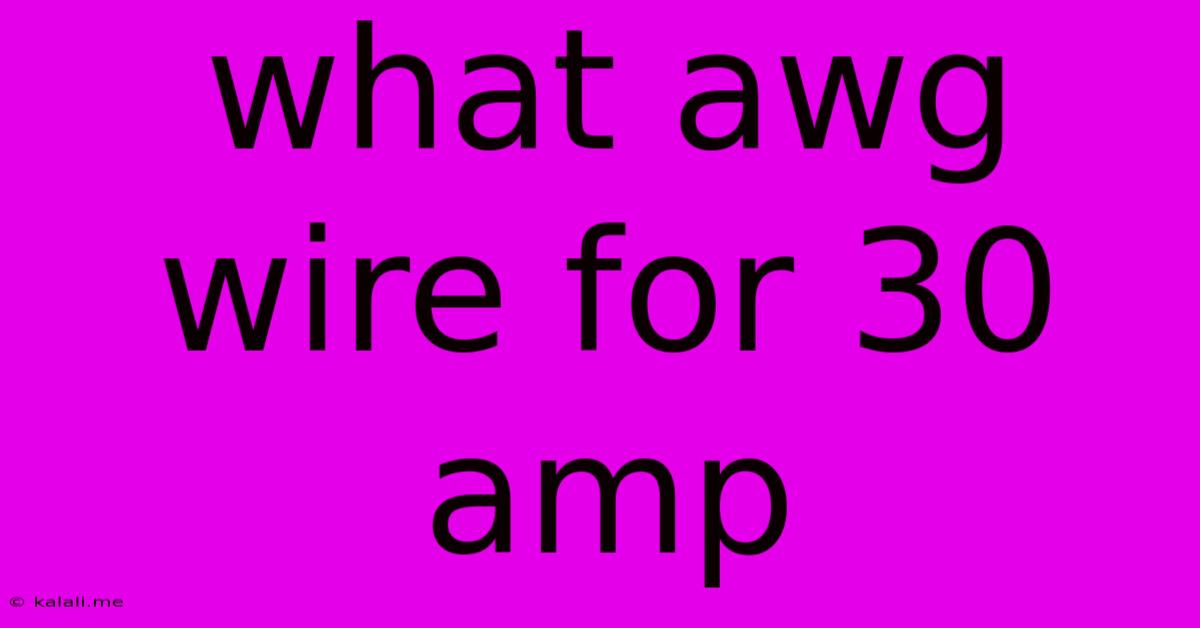What Awg Wire For 30 Amp
Kalali
May 27, 2025 · 3 min read

Table of Contents
What AWG Wire for 30 Amps? A Comprehensive Guide
Choosing the correct wire gauge (AWG) for your 30-amp circuit is crucial for safety and proper functionality. Undersized wire can overheat, leading to fire hazards, while oversized wire is unnecessary and wasteful. This guide will help you understand how to select the appropriate AWG wire for your 30-amp application, covering factors like voltage, material, and installation environment.
Understanding AWG and Ampacity
AWG, or American Wire Gauge, is a standard used to measure the diameter of electrical wires. The lower the AWG number, the thicker the wire and the higher its current-carrying capacity (ampacity). Ampacity refers to the maximum amount of current a wire can safely carry continuously without overheating. Selecting a wire with sufficient ampacity is paramount to prevent electrical fires and ensure the longevity of your electrical system. This is especially important for higher amperage applications like 30 amps.
Determining the Right AWG for 30 Amps: Key Considerations
Several factors influence the appropriate AWG wire for a 30-amp circuit:
1. Voltage:
-
120V Circuits: For standard 120-volt circuits, a 10 AWG copper wire is generally recommended for 30-amp applications. This provides ample current-carrying capacity with a safety margin.
-
240V Circuits: With a 240-volt circuit, the same current demands less amperage, allowing for the use of a slightly smaller gauge wire. However, always consult the relevant electrical codes and standards for your region. A 8 AWG copper wire is often suitable for 30-amp, 240-volt circuits but local regulations might dictate different requirements.
2. Wire Material:
-
Copper: Copper wire is the most common choice due to its excellent conductivity and relatively low cost.
-
Aluminum: Aluminum wire is lighter and less expensive than copper, but it has higher resistance and requires larger gauge wires for the same current carrying capacity. While usable, aluminum wire is generally less preferred for higher amperage circuits unless specifically called for in the design specifications.
3. Installation Environment:
The ambient temperature where the wire is installed impacts its ampacity. Higher temperatures reduce a wire’s ability to carry current. Installation in enclosed spaces, conduit, or direct sunlight can increase the ambient temperature and necessitate the use of a larger-gauge wire to maintain safety. Always consult the appropriate electrical code for your area concerning derating factors for different environments.
4. NEC and Local Electrical Codes:
The National Electrical Code (NEC) in the United States, and similar codes in other countries, provide detailed guidelines on wire sizing for electrical installations. These codes are designed to ensure safety and must be strictly adhered to. Local variations in these codes exist, so checking local building codes is critical before initiating any electrical work.
Choosing the Right Wire: A Step-by-Step Approach
- Determine the voltage: Is it a 120V or 240V circuit?
- Check local electrical codes: Consult the NEC or equivalent local codes for specific requirements.
- Consider the installation environment: Will the wire be installed in conduit, exposed, or in a high-temperature location?
- Select the appropriate AWG: Use the information above as a starting point, but always prioritize compliance with electrical codes.
- Consult a qualified electrician: If you're unsure, seek professional guidance from a licensed electrician. Electrical work can be dangerous, and incorrect wiring can pose serious risks.
Conclusion:
Selecting the correct AWG wire for a 30-amp circuit is essential for safety and efficient operation. While this guide provides valuable information, always prioritize adherence to local electrical codes and seek professional assistance if needed. Never compromise on safety when working with electricity. Remember that improper wiring can lead to serious consequences, including electrical fires and injury.
Latest Posts
Latest Posts
-
How To Repair A Soaker Hose
May 28, 2025
-
How To List Questions In A Paragraph
May 28, 2025
-
Cheapest Way To Buy Lego Bricks
May 28, 2025
-
2 Phase To 3 Phase Transformer
May 28, 2025
-
In Sample Vs Out Of Sample
May 28, 2025
Related Post
Thank you for visiting our website which covers about What Awg Wire For 30 Amp . We hope the information provided has been useful to you. Feel free to contact us if you have any questions or need further assistance. See you next time and don't miss to bookmark.